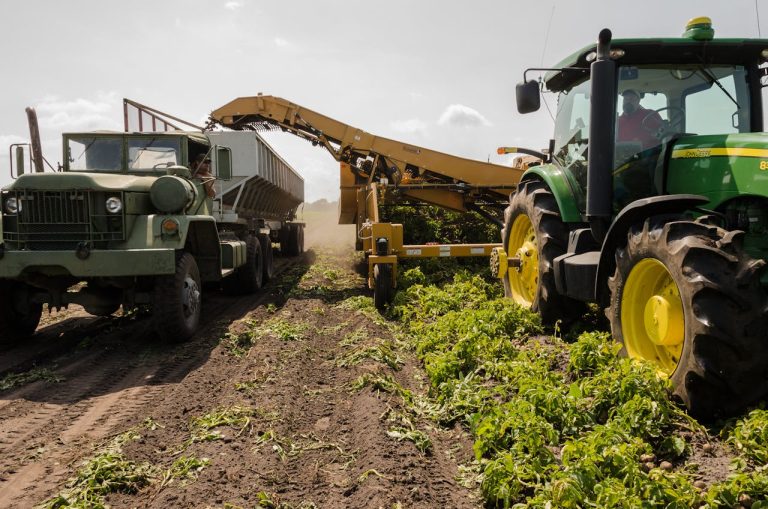Products made with United States prison labor can be found on grocery store shelves throughout the nation and beyond. That labor is often coerced, with little to no pay, and with minimal protections despite harsh and dangerous conditions – and it’s all legal.
The Pulitzer Prize-winning investigative reporting duo Margie Mason and Robin McDowell exposed just how deeply our supply chain relies on prison labor in their “Prison to Plate” investigation. Their three–part series shows the hardships prison workers face as modern-day indentured laborers. In many cases, as non-employees, they are not afforded workplace safety standards, are not allowed to unionize, and have limited grounds on which to sue when injured, mistreated, or even killed on the job.
The Associated Press duo also won the 2015 Barlett & Steele Gold Award for their “Seafood from Slaves” investigation and the 2021 Barlett & Steele Silver Award for their “Fruits of Labor” investigation.
Mason and McDowell took The Reynolds Center behind the scenes of their most recent two-year investigation.
Why prison labor in the United States?
After decades of reporting in Asia on human rights and labor abuses, Mason and McDowell decided to take a closer look at these issues in their home country. “It was after working overseas so many years and seeing abusive labor practices and then coming back here and seeing that the same thing is happening. It’s just in prisons,” McDowell said.
The COVID-19 pandemic brought into focus the labor disparities between the general population and inmates working in prisons. “Why are these people being tasked with making hand sanitizer and face masks in prison and everybody else, all the other Americans working, are being told to stay home and protect themselves and protect others in the public?” Mason said.
The team also noticed a substantial discrepancy in how the U.S. treats prison labor domestically versus internationally. Section 307 of the Tariff Act of 1930 “prohibits importing products that are mined, produced, or manufactured, wholly or in part, by forced labor, including by forced or indentured child labor.”
However, according to the 13th Amendment of the U.S. Constitution, slavery and involuntary servitude are illegal “except as a punishment for crime whereof the party shall have been duly convicted.”
Mason and McDowell were intrigued by the “hypocrisy” of these laws that hold other countries to a higher moral standard than the U.S. and decided to explore what that means for American inmates and the nation’s food supply chain.
“We know it’s a good story if we are neck deep in it and are still learning and surprised,” McDowell added.
Sourcing
While reporting abroad, the duo learned to conduct in-depth investigations without access to public records. They resorted to “boots-on-the-ground reporting” which came in handy during their “Prison to Plate” investigation.
Mason and McDowell followed the money, quite literally, by tailing trucks and prison work vans to track for themselves where the forced-labor produce was going. They discovered, for example, that inmate-raised beef was going to various major companies, such as Costco, Walmart, and Tyson Foods.
Reporting in the United States, they didn’t have to exclusively rely on hands-on, in-the-field reporting. Mason and McDowell leveraged their right to request and receive public records. “We’ve definitely been able to use the public records here, and that’s been a challenge, but also it’s been extremely helpful,” Mason said.
Through extensive Freedom of Information Act (FOIA) requests, the duo linked agricultural produce harvested by prison labor to products sold by massive American corporations, often violating their own sourcing policies.
Human sources were also vital to their reporting. The team interviewed more than 100 current and former prisoners, as well as family members of inmates who were killed while working their prison jobs. While sourcing and connecting with imprisoned people can be difficult, Mason and McDowell have found inmates much more approachable than the public and even other reporters may believe them to be.
“You can call anybody; you can email anybody, and people want to talk. If they don’t have a story, they know somebody who does have a story. If it’s not safe for them to talk, they know people who are outside who have experienced things,” McDowell said.
Trauma-informed reporting
As investigative reporters uncovering institutional wrongdoings that affect real people, Mason and McDowell are committed to minimizing harm in their reporting. Most of their human sources in their recent investigation have experienced trauma due to forced prison labor or have lost a loved one to it; investigating these events has the potential to cause further damage if done without care and consideration.
“We are incredibly careful, and we talk and think a lot about how our reporting – even if the person doesn’t think it could harm them – how it might harm them in a way that they don’t understand,” Mason said.
They emphasize the importance of thoroughly explaining to sources the implications of their testimony being published in a large media outlet and discussing whether they could face any danger, especially for those who are still incarcerated. Frequent check-ins with sources throughout the reporting about their comfort and willingness are also foundational to their journalistic approach.
“Robin and I have hours of conversations about this stuff sometimes … and we’ll go to our editor and talk about it, and I think that that’s what you do. That’s the smart thing to do,” Mason said.
The challenges
Reporting in the United States came with its perks for the two journalists: speaking to sources in English, having access to public records, and more independence on reporting trips. The massive investigation wasn’t free of challenges, though.
As McDowell describes it, the quintessential investigative reporting scene of tailing vehicles for potential leads was not all fun and games: “A lot of times you’re just following, and it sounds like it’s going to be this exciting journalistic pursuit, but they’re just going back to the trucking depot or something, or you’re driving for two hours and they’re not going anywhere … So there’s a lot of false starts.”
Coordinating the FOIA requests they submitted across all 50 states was a complex process as well. Mason said that “managing the FOIAs was very time-consuming and difficult and having to … go back and forth so many times to get clarifications” was challenging, especially when response times and processes can vary by state.
The hurdles didn’t stop when the investigation concluded. The intricate writing and storytelling process came with its own set of challenges. “Once you amass all of this information … How are you going to put this all into stories? What exactly are the stories going to be? How are they going to be shaped? How do you get all this stuff in here without losing readers? How do you arrange it?” Mason said.
How they make joint-reporting work
Mason and McDowell have worked together for nearly 20 years. Both reporters are heavily involved in all aspects of the investigation and the writing process, but McDowell is especially passionate about old-fashioned shoe-leather reporting and Mason is strongly drawn to the narrative components of telling the story.
They say they “share a brain” and can pull each other out of ruts during the different stages of an investigation. When one of them can’t see what is missing in the story, the other one is usually able to look at the story with fresh eyes and say, “we need to do X, Y and Z to fix this,” Mason said.
“We think a lot about the writing. We think as much about the writing as we do about the reporting,” she added.
Doing justice to the facts and findings relies heavily on how they are presented to the audience. A boring or convoluted narrative has the potential to turn away readers from the story altogether, missing out on what the investigation uncovers and why it matters.
“You can’t just … load people down with numbers and just a bunch of percentages … you’ve got to be mindful,” Mason said.
Advice to early-in-career journalists
Maintaining a professional relationship in which the roles of journalist and source are clear is needed to conduct ethical, unbiased journalism. However, Mason and McDowell have learned throughout their decades of experience that it’s best to approach sources as people first and foremost, especially when dealing with victims of wrongdoing.
Mason pointed to their time in Indonesia covering the “Seafood from Slaves” investigation: “We actually intervened and got a number of men off of the island before our story published … We very much changed the course of the reporting by getting involved because we were worried about what might happen to [our sources] if we published.”
After raising their concerns to top leadership at the AP, the news outlet decided that intervening would minimize harm for the victims in the story, even if it meant blurring the lines between the reporters and their subjects.
“Yes, you don’t want to get super close and super involved with your sources. There is a line there, but I think that it’s also not black and white,” Mason added.
For reporters covering dailies, breaking news, or other quick-turn-around stories, the duo encourages them to view their current coverage through an investigative lens.
“Whatever story you’re doing, you can have investigative elements in it…if it’s a daily story, you can just dig a little bit deeper and just give it a little bit more context and depth and give it a little more edge,” Mason said.
“Even if it’s a court hearing, just do something better than the competition, like go a little deeper, add the historical element or the numbers that other people aren’t putting in,” McDowell said.
Mason and McDowell are currently working on the fourth installment of their “Prison to Plate” investigation. Read Part One, Part Two, and Part Three.
For more insights on doing investigative business reporting, check out “Chapter 9: Investigative” of The Reynolds Center’s Business Beat Basics: A Guide to Covering All Things Business.











